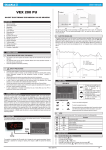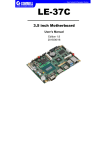Download DIAL1602
Transcript
AUTOMATIC TELEPHONE ALARM DIALER DIAL 1602M OPERATION AND INSTALLATION INSTRUCTION MANUAL ROGER s.c. DIAL 1602 v1.0 25/11/1999 TABLE OF CONTENTS POWER SUPPLY TABLE OF CONTENTS................................................................ 1 INTRODUCTION.......................................................................... 1 OVERVOLTAGE PROTECTION .................................................. 1 INSTALLATION OF THE DIALER ................................................ 1 POWER SUPPLY......................................................................... 1 DIALER MEMORY KEEP-UP WITH A BATTERY......................... 1 STRUCTURE OF THE CONTROL INPUTS A, B and C ............... 1 CONNECTION OF THE ALARM LINES A AND B ........................ 1 CONNECTION OF THE BLOCKING LINE.................................... 1 CONNECTION OF THE TELEPHONE LINE ................................ 1 CONNECTION OF THE PGM OUTPUT ....................................... 2 DIALER CODES........................................................................... 2 INSTALLER CODE ................................................................ 2 USER CODE.......................................................................... 2 CONFIGURATION CODE ...................................................... 2 DURESS CODE..................................................................... 2 CODE ENTRY \ ALARM RESET .................................................. 2 DIALER TESTING ........................................................................ 2 SWITCHING ON THE POWER SUPPLY ..................................... 2 DIALER OPERATING MODES..................................................... 2 PROGRAMMING MODE .............................................................. 2 [1] Programming the numbers ................................................ 2 [2] Recording/Playing of Alarm Announcement....................... 2 [3] Installer/User Code............................................................ 3 [4] Programming of the date and clock ................................... 3 [5] Dialer configuration............................................................ 3 [6] Read-out of the Event List ................................................. 3 [0] Exit from the programming mode....................................... 3 BLOCKING MODE ....................................................................... 4 READY MODE ............................................................................. 4 ALARM MODE ............................................................................. 4 Single message dialer. ........................................................... 4 Double message dialer........................................................... 4 DURESS ALARM ......................................................................... 4 PAUSE MODE ............................................................................. 4 Single message dialer ............................................................ 4 Double message dialer........................................................... 4 TELEPHONE LINE LISTENING ................................................... 4 EXTERNAL CALL ANSWERING FUNCTION............................... 4 TECHNICAL SPECIFICATION ..................................................... 4 DRAWINGS.................................................................................. 4 The dialer requires DC power supply from 11 do 15V. A loss of power supply results in resetting the dialer time and date, however, the other information stored in the dialer memory is not lost. When the allowable voltage (15V) is exceeded or the voltage polarity is wrong, it may cause, besides burning the F1 fuse, damage to the dialer. DIALER MEMORY KEEPKEEP-UP WITH A BATTERY The dialer is originally equipped with a 3V/120mAh battery, which guarantees keeping up the memory for minimum 60 days in case of a power supply loss. The memory stores the alarm telephone numbers, alarm messages, history of events and dialer configuration parameters. A power supply loss results only in resetting the time and date. A lack or low battery (voltage lower than 2.7V) at a power supply loss results in resetting the dialer memory and restoration of the default parameters of dialer configuration. The condition of the battery should be checked after each loss of power supply but not less frequently than once per year. If you want to reset the dialer programming and restore its default values of codes and configuration parameters (which can occur when you have forgotten the currently programmed access codes), you should interrupt the battery supply of the dialer RAM memory by inserting an insulation material strap under the battery holding plate and switching off the power supply for 1 minute. If after switching the power supply on again, the dialer displays the message DIALER PROGRAMMING RESET, you should connect the battery supplying the RAM memory and program the dialer. In case of difficulties with resetting the RAM memory in the described above method, you should repeat all the steps and additionally close the JP7 jumper contacts for a moment with a metal object after switching off the power supply and disconnecting the battery. STRUCTURE OF THE CONTROL INPUTS A, B and C Activation of the T1 transistor, when the line is programmed as NO, results in a release of the line. In case the line is programmed as NC, deactivation of the T1 transistor results in a release of the line. The blocking line C is permanently configured as a NO type line. CONNECTION OF THE ALARM LINES A AND B INTRODUCTION Depending on the configuration of the alarm line (NO or NC), different systems of the alarm line release are used. The alarm criterion on the alarm input can be performed by giving the suitable voltage or with a non-potential contact with a serial resistor. Please note that the presented systems of the voltage release of the line apply when the dialer and the releasing device have a shared power supply minus (ground) cable and the use of the control output with a signaling device is only an example of a solution, the alarm input can be controlled from any other source of power supply. The alarm dialer transmits via telephone an announcement on an occurrence of an alarm at the supervised facility. The DIAL 1602 can be configured as a dialer with one alarm message and ten alarm telephone numbers or two messages and five alarm numbers designated for each of the messages. The latter solution allows for distinguishing the alarm type (e.g. burglary and fire) and commencing a notification action suitable for the type of danger. The DIAL1602 can be also used as a two-zone alarm exchange, since it is provided with an alarm signaling output, an input to connect a coder and the complete range of programming of delays for an entry and exit from the facility, alarm times, etc. CONNECTION OF THE BLOCKING L LINE INE OVERVOLTAGE PROTECTION The C blocking line is controlled in the identical manner as the alarm line, programmed as NO. Programming the blocking line as NC is not possible. The DIAL 1602 is designed in such a manner that it is resistant to overvoltage occurring in a telephone line up to 2kV. If a telephone line is not provided with an efficient overvoltage and lightning protection system, an atmospheric discharge may cause an overvoltage in it, which could be much higher than 2kV. A repair of damage caused by atmospheric discharges is not included in the warranty. When there is danger of such damage, it is recommended to install a special protective system connected in between the dialer and telephone line. CONNECTION OF THE TELEPHONE LINE The telephone line wires are connected to the terminals no. 9 and 10, the telephone to the terminals no. 7 and 8. This method of connection provides that during an alarm action, the telephone is disconnected from the telephone line and therefore it is not possible to block the telephone line by the wrong hang-up of the speaker. The telephone can be also connected parallel with the dialer, i.e. to the terminals no. 9 and 10 but in this case, in older type telephones, you can hear the dialing tones generated by the dialer and it will be also possible to block the telephone line, thus the dialer, by the wrong speaker hang-up. INSTALLATION OF THE DIALER Electronic elements used in the device are sensitive to static potentials. The elements cannot be touched or handled with any tools. The dialer should be installed in an enclosed room, far from any sources of moisture and heat. Power supply should be connected after completion of all electrical connections. -1- ROGER s.c. DIAL 1602 v1.0 25/11/1999 CONNECTION OF THE PGM OUTPUT Note ! The captions in the following part of the text in "[ ]" brackets are also messages which are displayed on the dialer display at various stages of its use and operation. test the RAM memory. If the dialer programming has been lost, the [First start of dialer] message is displayed, and then [DIALER PROGRAMMING LOST !] / [ ENTER DEFAULT CODE]. Then you should press the [#] key and after message [Enter code] is displayed, you should enter the default installer code, i.e. 1234; end the code entry with the [#] key. The dialer will go to the programming code. If after switching on, the power supply the RAM test is successful, the message [Dialer Restart] will be displayed and the device will switch to the ready mode. The pulsing display signalizes a necessity of programming the time and date. After a restart, despite resetting the time and date, the RAM memory is not reset and the dialer monitors the alarm inputs and is ready to handle the alarm in the A or B line. DIALER CODES DIALER OPERATING MODES The dialer has four codes. Each of the codes, except for the duress code, can include up to 6 digits. A code can be programmed as a blank one, then after a request [Enter code] you should only press the [#] key. The codes are also used for changing various operation modes of the dialer (see "Schematic of changing the modes"). The DIAL 1602 can operate in one of the following operating modes: - programming mode - blocking mode - ready mode - alarm mode - pause mode The PGM output signalizes switching the dialer into the condition of a loud alarm. It can also signalize switching into the ready mode (see the dialer configuration). It is an "open collector" type output and can be added with an additional relay to activate signaling devices. The maximum current at the output should not exceed 500 mA. INSTALLER CODE The default setting is 1234. It is used to exit the current operation mode (together with the alarm mode) and to enter the programming mode. PROGRAMMING MODE You can go to the programming mode from any mode by entering the installer code. [#] – starts the code entry [Installer code][#] USER CODE The default setting is 1111. It is used to interrupt the alarm action, enter or exit the ready mode. You can enter one of the 6 programming procedures by selection of the suitable key (1..6). You can exit any of the procedures by a single or double use of the [#] key. If you change the dialer configuration from a single message dialer to a double message dialer or inversely during the dialer programming, you must enter the configuration procedure no. [5] and select the proper option prior to programming the telephone numbers and pre-recording the announcement(s). CONFIGURATION CODE The default setting is 1234. It is used to enter the dialer configuration procedure in the programming mode. DURESS CODE Entering the sequence of characters [*][digit][*] in the blocking or ready mode, results in activation of the duress alarm. The digit between the [*] symbols is preset as [0] and can be reprogrammed during the dialer configuration procedure. [1] Programming the numbers In case of a single message dialer, you can program up to 10 telephone numbers (maximum a 16-digit number) marked from L1 to L10 in the list. In case of a double message dialer, you can program up to 5 numbers in the list "A" (from A1 to A5) and up to 5 numbers in the list "B" (from B1 to B5). You use the [*] key to go to the next number in the list. Any numerical key resets the old number and starts a stand-by mode of waiting for the new number digits. You end the number entry with the [*] key. The [#] key used during entering the telephone number digits enters the character "P" (pause). The character makes the system wait for a dial tone. If the signal is recognized, the device starts dialing the next digits of the number. If the dialer does not recognize the continuous signal within 4 seconds, it unconditionally starts dialing the next digits of the telephone number. You can skip the telephone number programming function when getting to the last number in the list (L10 or B5) or earlier by pressing [#]. The character P in the telephone number is used when dialing long distance connections (e.g. 0P22340967), when you expect a long time of waiting for an telephone exchange tone or if for any other reasons you have to force an interruption in dialing (which is often required for older type subscriber telephone exchanges). CODE ENTRY \ ALARM RESET If you want to enter the user or installer code, you should stop the current mode with the [#] key. The system will display the following message [Enter code _ ], then you should enter the correct installer or user code and end it with [#]. The program allows three attempts of entering the code. After the third unsuccessful attempt, the program blocks the keypad for 3 minutes and records the [Wrong code entered] message in the event list. If within 30 seconds from the moment of displaying the [Enter code] message the code is not entered, the attempt will be qualified as the wrong code. You can interrupt the alarm action or a pause after it by entering the installer or user code. The alarm action can be also interrupted by releasing the C blocking input for a time longer than 200 ms. DIALER TESTING Each time the dialer enters the ready mode, it previously tests the telephone line, A and B alarm inputs and microprocessor system. The telephone line tests check if a telephone exchange tone exists. The alarm line test checks if there are no alarm tones in the lines during the test. The microprocessor system test verifies its correct operation. The test end is signalized with displaying the [Negative tests N] message, where the number N stands for the quantity of negative tests. The test results are recorded in the list of events. [2] Recording/Playing of Alarm Announcement Note ! After each time a new announcement is recorded, you should listen to it using the headphone output to make sure the announcement is readable and, if needed, repeat recording. You should record alarm announcement(s) by speaking to the built-in microphone from a distance of about 20cm. The start of recording is signalized with an acoustic tone. The recording is ended automatically after the available recording time has elapsed (14s for a single message dialer or 7s for a double message dialer). The duration of an announcement can be shortened by pressing [#]. You can exit the Record/Play procedure with the [#] key. SWITCHING ON THE POWER SUPPLY After the power supply has been switched on, the dialer checks the value of the power supply voltage and if it is too low, the [Low power supply voltage] message is displayed. Until its value reaches the suitable level, the dialer will not go to the next steps of the start procedure. When the power supply voltage is higher than 9.5V, the dialer will display the [Roger DIAL1602] message and -2- ROGER s.c. DIAL 1602 v1.0 25/11/1999 [3] Installer/User Code To reprogram the code, you should first determine which code will be changed ([0] or [1] key) and then, by pressing any numeric key, reset the old code and enter the new one ending it with [#]. If you press [#] again, you will exit the code setting procedure. alarm line blocking from the moment the notification action was stopped, which was initiated in this line. It is shared by both alarm inputs. In case of a single message dialer, both alarm lines are blocked for the pause time regardless in which one the alarm was initiated (min.000min. max 255min.). [Duress code *0*] The digit between the * characters is programmed. [Configuration code 1234] By pressing any numerical key, you reset the old code and then enter the new code. You end the code entry by pressing the [#] key. [4] Programming of the date and clock By using [*], you can move the pulsing cursor at the position which is to be programmed. The first two digits specify the day of a month, the next two – the month, the remaining ones – the hour and minutes, you finish setting the date and time by pressing [#]. [5] Dialer configuration You enter the dialer configuration procedure after you have previously entered the valid configuration code. The dialer configuration is performed by selecting the suitable options, which are presented on the display. The pulsing cursor indicates the currently set option. By pressing [*], you go to the next elements of the configuration procedure. By using the [#] key at any moment, you enter the completed changes to the memory and exit the configuration. You change the current option by selecting [0] or [1]. When setting the times (delay, alarm and pause), [0] deducts one unit and [1] adds one unit to the current value. If you change the single message option to the double message or inversely, the dialer notifies about resetting the previously programmed announcement numbers and about a necessity of their reprogramming, after the exit from the configuration procedure. [6] Read-out of the Event List The program remembers the last 100 events regarding the alarm action and keypad operation. The description of an event is arranged so that the event date and time are displayed first and than its description is displayed. The event list starts with the last event. You can read out the event history using the following navigation keys: [2] displays an earlier event [8] displays a later event [4] moves the event description to the left [6] moves the event description to the right [5] returns the event description to its beginning You can also go to a later event by using the [*] key. You exit the event history read-out by pressing [#]. Note ! "[ ]" brackets contain the text of the messages displayed by the dialer, whereas the default (manufacturer's) values are put in bold. Dialer configuring procedure. [Alarm message number: 0-1 messages 1-2 messages] Option selection; 1 message 14s and 10 alarm telephone numbers in the L1-L10 list or 2 messages 7s each and two telephone number lists: A1-A5/B1-B5, five alarm numbers each. TYPE OF EVENT [Ready mode] [Blocking mode] [Alarm A] [Alarm B] [Pause in alarm NN minutes] Note ! If you change the dialer configuration from a single message to a double message dialer or inversely, the previously programmed telephone numbers and pre-recorded alarm announcements will be reset. [MN notification: O.K.] [Input A activation time: 0-200ms 1-2sec.] [Input B activation time: 0-200ms 1-2sec.] The minimum alarm duration time in the line A(B) required for initialization of the alarm action. [Line type A : 0-NC 1-NO] [Line type B : 0-NC 1-NO] Alarm line type NO/NC [Line A delay: 000s] [Line B delay: 000s] An alarm line delay is the time from the moment of an alarm line release to the moment when the dialer enters the alarm condition. (min.000s max.255s). [Silent alarm in line A: 0-NO 1-YES] [Silent alarm in line B: 0-NO 1-YES] When an alarm line is set as silent, the PGM output is not activated during an alarm and the dialer only performs the action of telephone notification. [Output delay 000s] This is a delay prior to switching to the ready mode (min.000s max 255s). [Ready mode activation confirmation: 0-NO 1-YES] The function activates the PGM output for 0.3s at the moment the dialer switches to the ready mode. [Blocking mode allowed: 0-NO 1-YES] When the blocking mode is allowed, the dialer can be used as a double line alarm exchange (see BLOCKING MODE). [Should dialer answer external calls: 0-NO 1-YES] see EXTERNAL CALL ANSWER FUNCTION [Telephone exchange type: 0-PULSE 1-DTMF] It specifies the method of dialing when cooperating with a telephone exchange. [PGM output alarm time PGM 000s] It specifies the duration of PGM output activation from the moment a loud alarm is switched on (min.000s max. 255s). [Pause between alarms 000min.] In case of a double message dialer, it specifies the duration of [Installer code entered] [User code entered] [Configuration code entered] [Wrong code entered] [Negative dialer test] [Dialer test O.K.] [MN telephone programming] [Dial restarted] [DIALER SWITCHED OFF] [Time setting] [User code change] [Installer code change] [Configuration change !] [Input C alarm interrupted] INTERPRETATION the dialer is in the ready mode the dialer is in the blocking mode an alarm in the line A an alarm in the line B the dialer is in the NN minutes pause mode a connection with the number N in the list M was made the correct installer code was entered the correct user code was entered the correct configuration code was entered despite three attempts the correct code was not entered a dialer test when switching to the ready mode found errors a dialer test when switching to the ready mode did not find errors the number N in the list M was programmed the dialer power supply was switched on, RAM memory test O.K. power supply was lost the date and clock were programmed the user code was reprogrammed the installer code was reprogrammed the dialer configuration parameters were changed the alarm action was interrupted by releasing the blocking input C [0] Exit from the programming mode Prior to an exit from the programming mode, the system checks if any telephone numbers and recorded announcements are stored in the dialer memory. If there are not any, the dialer displays the appropriate message. The system automatically exits the programming mode, if you do not press any key for 3 minutes. From the programming mode the dialer goes to the blocking mode -3- ROGER s.c. DIAL 1602 v1.0 25/11/1999 Double message dialer When the notification procedure is completed, the dialer switches to the pause during which it blocks the alarm input from which the alarm was initiated, monitors the other alarm input and is ready to start the alarm action from the line, provided it is initiated. During the notification action both alarm inputs are blocked. After the pause time has elapsed, the system returns to the ready mode and stops blocking both alarm inputs. (if it is allowed) or direct to the ready mode. See the schematic of changing the dialer modes. BLOCKING MODE The blocking mode, if allowed in the configuration procedure, enables a use of the dialer as a double line alarm panel. In the blocking mode the dialer ignores the alarm condition in the lines A and B. However, if such a condition occurs, the dialer displays the name of the line in which the alarm was initiated. You switch to the blocking mode (if it is allowed) from the alarm mode, pause mode or ready mode by entering the user code or by going to the programming mode (see the schematic of changing the dialer modes). TELEPHONE LINE LISTENING Using the headphone output, in addition to listening to the alarm announcement, you can listen to the notifications, since the telephone line tones are retransmitted to the headphone output. READY MODE EXTERNAL CALL ANSWERING FUNCTION In this mode the program monitors the alarm inputs. When an alarm is recognized in an alarm line, the system starts counting of the time delay for the specific line and then it goes to the alarm mode. Each time the ready mode is activated, which is performed after entering the user code, it is preceded by performing the system testing procedure and counting the output delay. When the blocking line C is released in the ready mode, the alarm inputs A and B are blocked. The lines A and B remain blocked as long as the line C remains released. The release condition of the blocking line C is signalized by displaying the letter C on the dialer display. The function allows you to obtain remote information if there was an alarm activated at the facility where the dialer is installed. You can get such information by dialing the dialer telephone number. In this function the dialer, being in the ready mode, after recognition of 8 call tones, connects into the telephone line and transmits an acoustic signal for 20s. If no alarm occurred at the facility from the time the dialer went to the ready mode, the transmitted acoustic signal is a two-second acoustic tone, repeated cyclically. If there was an alarm at the facility, which was not reset, the dialer transmits a signal, which is modulated in the identical way as the signal preceding the alarm announcement. ALARM MODE TECHNICAL SPECIFICATION Single message dialer. After recognition of the alarm condition in the line A (B), the dialer begins counting the A (B) input delay. If you do not enter the correct user or installer code during the counting of the input delay, the dialer will start dialing the numbers in the list L1..L10, in the sequence the numbers were put in the list. After making the connection, the dialer transmits the alarm tone and announcement five times, then it goes to the next number. The described action is repeated twice. During the alarm action any signals in the alarm inputs A and B are ignored. Power supply Input current in ready mode Dimensions L x W x H Temperature range DRAWINGS Double message dialer In this case the alarm mode initialization algorithm is identical as for the single message dialer. The difference is that if an alarm was activated in the input A, the system dials the numbers from the list A1..A5 and the announcement A is transmitted. If an alarm was activated in the line B, the system dials the numbers from the list B1..B5 and the announcement B is transmitted. During the alarm action the dialer displays two letters informing about the type of the current alarm action and the name of the alarm input, which initiated the alarm, to the right from the caption Ready. Alarm types: AG – loud alarm AC – silent alarm AN – duress alarm (activates the PGM output) (does not activate the PGM output) (silent alarm in the line A) DURESS ALARM You can initiate the duress alarm in the Blocking or Ready mode by entering the duress code: [*] digit [*] Regardless the line A programming as silent or loud, or the dialer configuration as single message or double message, the duress alarm is performed silently and corresponds the alarm initialization in the line A. Following the completion of the duress alarm, the dialer goes direct to the Ready mode. PAUSE MODE Single message dialer When the notification procedure is completed, the dialer switches to the pause during which it blocks both alarm inputs. After the pause time has elapsed, the system returns to the ready mode and stops blocking both alarm inputs. -4- 11V..15V typically 45mA 215 X 95 X 27 0..50 C˚ ROGER s.c. DIAL 1602 v1.0 25/11/1999 -5- ROGER s.c. DIAL 1602 v1.0 25/11/1999 Schematic of changing the DIAL1602 dialer operating modes. NOTE ! Pause after the duress alarm equals 0 minutes. (INSTAL. CODE-Installer code; USR. CODE-User Code) -6-























